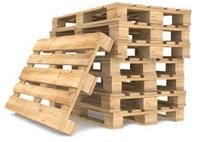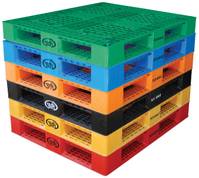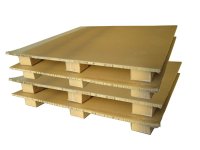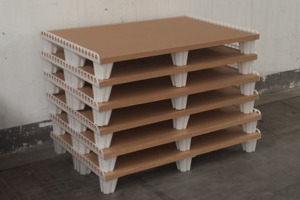The Sexy and Exciting World of Pallets

When shipping goods, it makes a lot of sense to palletize or unitize the cargo. The principle is simple: instead of handling each piece of cargo manually, it is grouped together into bundles of some kind- otherwise known as unit loads. That way, the amount of handling and effort is reduced along with potential damage to the product and even worker injuries. In addition, once goods are unitized, the amount of packaging required can even sometimes be reduced creating further savings.
So, with the goods unitized, what kind of platform should be used to move them around?
 By far, the most popular material for creating pallet platforms is wood. There are plenty of good reasons: It’s cheap, it’s strong, readily available in most parts of the world and it’s renewable. To create a wood pallet, the investment is relatively low because all that is needed is lumber, labor, skills and carpentry tools. Of course, for mass-produced pallets, the equipment is more complicated, but you get the general idea.
By far, the most popular material for creating pallet platforms is wood. There are plenty of good reasons: It’s cheap, it’s strong, readily available in most parts of the world and it’s renewable. To create a wood pallet, the investment is relatively low because all that is needed is lumber, labor, skills and carpentry tools. Of course, for mass-produced pallets, the equipment is more complicated, but you get the general idea.
The down-side to wood pallets is that, since they are made from a living material, they can transport organisms so for international shipments, they must be heat-treated or fumigated.
Although it makes up a relatively small share of the pallet world, plastic is another highly suitable material for making pallets. Unlike wood pallets, plastic pallets don’t have to be heat treated or fumigated when used in international transportation. They can also be easily washed if they are being used for food transport or other uses that require cleaning. Some say they are more durable although it depends on the type of pallet and keeping in mind that wood pallets can be repaired more easily than plastic ones.
material for making pallets. Unlike wood pallets, plastic pallets don’t have to be heat treated or fumigated when used in international transportation. They can also be easily washed if they are being used for food transport or other uses that require cleaning. Some say they are more durable although it depends on the type of pallet and keeping in mind that wood pallets can be repaired more easily than plastic ones.
The main reasons plastic pallets don’t make up a larger share of the pallet market is that the investment required to manufacture plastic pallets is much higher than wood. So they tend to be shipped longer distances without a load on them which drives up the cost. There is also some controversy over the flammability of plastic vs. wood which we’ll save for another blog. Suffice it to say…this is an issue.
 Another alternative is the paper pallet like the ones shown here by IKEA. Also renewable, paper pallets are generally only used once. They are lighter, easily recycled, less expensive than plastic pallets and exempt from the fumigation and heat treatment requirements. Unlike wood and plastic, paper pallets cannot be ‘racked’ in warehouses that have standard racking. This can be overcome with the use of a ‘slave-pallet.’
Another alternative is the paper pallet like the ones shown here by IKEA. Also renewable, paper pallets are generally only used once. They are lighter, easily recycled, less expensive than plastic pallets and exempt from the fumigation and heat treatment requirements. Unlike wood and plastic, paper pallets cannot be ‘racked’ in warehouses that have standard racking. This can be overcome with the use of a ‘slave-pallet.’
The main disadvantage of a paper pallet is that if the ‘feet’ of the pallet or the portion that touches the floor becomes wet (a more common occurrence than you might think), they quickly lose their strength and can fail. Also, they are generally less durable in transit than other alternatives. That being said, if proper handling techniques are used, they should work fine.
Invented by IKEA, the OptiLedge® is another unique alternative. (Full disclosure…my name is Mr.  OptiLedge) and played a key role in allowing IKEA to completely eliminate wood pallets from their supply chain. Whether used with a substrate of corrugated material as shown here (The OptiPal®) or on its own, this is a unique alternative. Like paper pallets, it is not rackable in standard racking but users can either use slave pallets or adapt their racking as IKEA has done.
OptiLedge) and played a key role in allowing IKEA to completely eliminate wood pallets from their supply chain. Whether used with a substrate of corrugated material as shown here (The OptiPal®) or on its own, this is a unique alternative. Like paper pallets, it is not rackable in standard racking but users can either use slave pallets or adapt their racking as IKEA has done.
Other advantages include the fact that it is exempt from fumigation and heat treatment requirements, and is very lightweight. Unlike traditional plastic pallets, the OptiLedge nests together when not in use. This means it is easier to service customers over a large area because it is efficient in transit. Unlike traditional paper pallets, the OptiPal has waterproof feet so it does not lose strength if it is in a wet environment.
We’ll cover other platforms on future blogs including slip sheets (no platform at all) and the use of special materials handling equipment like ROLLERFORKS®
I hope you’ve enjoyed this brief overview of the exciting world of pallets.
